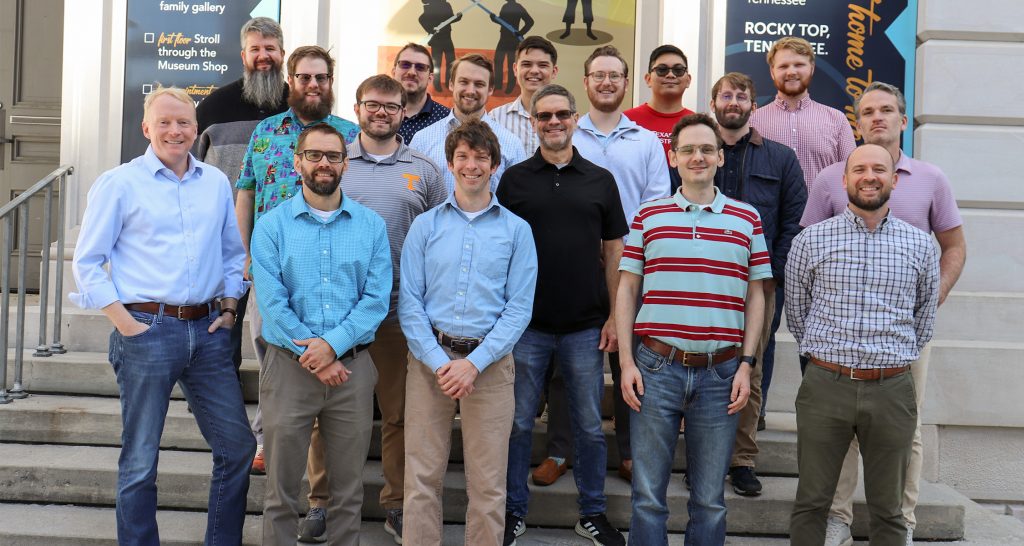Hands-On Experience Make Vols Adept Engineers
Blalock-Kennedy-Pierce Professor Ben Blalock has long embodied the Torchbearer ideal.
He discovered his love of teaching as an undergraduate teaching assistant in the Min H. Kao Department of Electrical Engineering and Computer Science (EECS).
“Helping students in the lab and seeing the light bulb turn on was extremely gratifying,” he recalled.
At the time, there were only three professors at the University of Tennessee who focused on electronics and analog circuit design: Eldredge Kennedy, James M. Rochelle, and Blalock’s father, T. Vaughn Blalock, one of the professors for whom his position is named.
The younger Blalock returned to UT as a faculty member in 2001, bringing with him the Integrated Circuits and Systems Laboratory (ICASL). He currently advises five full-time graduate students, as well as two others who are pursuing their degrees while working full-time at Texas Instruments (TI) Knoxville.
Those two bring the total number of ICASL alums currently working at TI Knoxville to 14. Another eight ICASL alums are employed at TI locations elsewhere in the nation.
Blalock credits Vols’ high success rate at the Fortune 500 company with the practical experience they receive at UT.
“When I was an undergrad here, my father and his colleagues were really hardcore about hands-on projects, and I’ve tried to carry that standard forward,” he said. “Our curriculum emphasizes analytical thinking, intuition, and the ability for students to think on their feet, and the most intense situation where students experience that is trying to get a hardware project working.”
Richard Stair, TI Knoxville’s general manager and Battery Charging Products design manager, understands the importance of practical experience from both the student and hiring perspectives. After earning his bachelor’s degree in EECS at UT in 1998, he worked at TI Dallas for several years. He came back to Rocky Top in 2005 to lead TI Knoxville.
“We love hiring UT engineers because they are already familiar with Knoxville, and we know they get a great education,” Stair said. “Regardless of where you earn your degree, there is a tremendous amount of additional learning required once you get into industry. But having a good foundation is essential to long-term success.”
EECS Teaches Research, Resourcefulness
Many of Blalock’s former students remember and appreciate the hardware projects they worked on at UT, which often incorporate technology supplied by TI. In many cases, they can trace their career success back to those projects.
Jordan Sangid (EECS BS ’16, MS ’18, PhD ’22) managed a music venue for several years before returning to UT to pursue electrical engineering. He was an ICASL member for seven years, starting as an undergrad, and fondly remembers his deeply personal master’s thesis.
“Designing a Class D Guitar Amplifier was a meaningful project that beautifully blended my passions for music and engineering,” said Sangid, who is now an analog design engineer within TI Knoxville’s Battery Monitor Products group. “The practical skills I developed, especially in PCB design and working on complex technical projects, were directly applicable to my current role.”
ICASL students also have incredible opportunities to work on federally funded projects with broad impact.
“All of my ICASL students were supported by research funding from federal agencies,” Blalock said, “especially the National Aeronautics and Space Administration, the Department of Defense, and the National Science Foundation.”
Patrick Buchanan (EECS BSMS ’22) joined ICASL as an undergraduate and returned to conduct his graduate research. Under Blalock’s guidance, and with funding from NASA, Buchanan created a voltage reference circuit for devices that could be used in space exploration. After his master’s degree, he was hired at TI Knoxville as an analog design engineer.
“When I was at ICASL, we were designing specifically for ultra-low-temperature and high-radiation moons and planets,” Buchanan recalled. “It was my first exposure to references, and the application space provided unique challenges. Now I help design the transistor-level circuits that make our chips run: everything from references to amplifiers to gate drivers.”
Agility Leads to Real Impact
Stair says the research experience EECS students gain in labs like ICASL and the standard curriculum makes them very attractive job applicants.
“Learning how to track down information without direct guidance, then pull that together to solve a problem is something researchers have to do, and this skill is also valued in industry,” Stair explained.
In true Torchbearer fashion, Blalock feels that seeing his former students achieve success in high-caliber engineering positions is the most satisfying goal he could achieve.
Whenever he meets with one of his alumni for lunch in Market Square, he marvels at the impact his students are having on the world.
“At TI Knoxville, they’re designing chips that go into the mobile devices that are integral to our daily lives, and the power electronics for data centers which are backbone of AI,” he said. “They are effectively elevating everyone’s standard of living, and that’s how it should be. Hopefully, I’ve done something to contribute to that.”
Contact
Izzie Gall (egall4@utk.edu)
